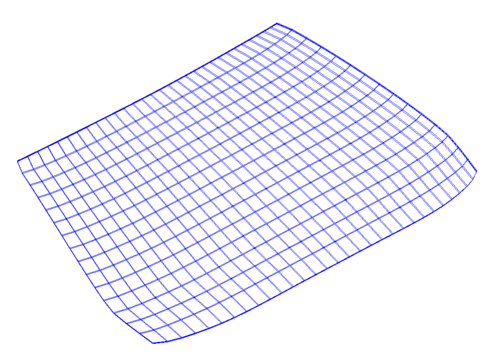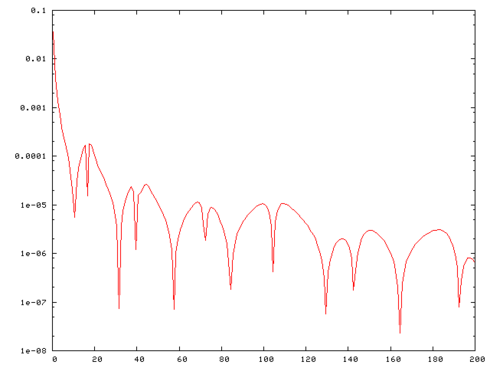(Init Windscreen) |
(Added dimension section and fixes) |
||
| Line 6: | Line 6: | ||
==Description== |
==Description== |
||
<figure id="fig1">[[File:Windscreen1.gif|490px|thumb|right|Figure 1]]</figure> |
<figure id="fig1">[[File:Windscreen1.gif|490px|thumb|right|Figure 1]]</figure> |
||
| − | <figure id=" |
+ | <figure id="fig2">[[File:Windscreen2.png|490px|thumb|right|Figure 2]]</figure> |
This is an example for a model in the frequency domain of the form |
This is an example for a model in the frequency domain of the form |
||
| Line 19: | Line 19: | ||
The test problem is a structural model of a car windscreen. |
The test problem is a structural model of a car windscreen. |
||
This is a 3D problem discretized with <math>7564</math> nodes and <math>5400</math> linear hexahedral elements (3 layers of <math>60 \times 30</math> elements). |
This is a 3D problem discretized with <math>7564</math> nodes and <math>5400</math> linear hexahedral elements (3 layers of <math>60 \times 30</math> elements). |
||
| − | The mesh is shown in |
+ | The mesh is shown in <xr id="fig1"/>. |
The material is glass with the following properties: |
The material is glass with the following properties: |
||
The Young modulus is <math>7\times10^{10}\mathrm{N}/\mathrm{m}^2</math>, the density is <math>2490 \mathrm{kg}/\mathrm{m}^3</math>, and the Poisson ratio is <math>0.23</math>. The natural damping is <math>10\%</math>, i.e. <math>\gamma=0.1</math>. |
The Young modulus is <math>7\times10^{10}\mathrm{N}/\mathrm{m}^2</math>, the density is <math>2490 \mathrm{kg}/\mathrm{m}^3</math>, and the Poisson ratio is <math>0.23</math>. The natural damping is <math>10\%</math>, i.e. <math>\gamma=0.1</math>. |
||
The structural boundaries are free (free-free boundary conditions). |
The structural boundaries are free (free-free boundary conditions). |
||
The windscreen is subjected to a point force applied on a corner. |
The windscreen is subjected to a point force applied on a corner. |
||
| − | The goal of the model reduction is the fast evaluation of y. |
+ | The goal of the model reduction is the fast evaluation of <math>y</math>. |
Model reduction is used as a fast linear solver for a sequence of parametrized linear systems. |
Model reduction is used as a fast linear solver for a sequence of parametrized linear systems. |
||
| Line 32: | Line 32: | ||
\{0.5j,j=1,\ldots,m\}</math> with <math>m=400</math>. |
\{0.5j,j=1,\ldots,m\}</math> with <math>m=400</math>. |
||
| − | + | <xr id="fig1"/> and <xr id="fig2"/> show the mesh of the car windscreen and frequency response function. |
|
==Origin== |
==Origin== |
||
| − | This benchmark is part of the '''Oberwolfach Benchmark Collection'''<ref name="korvink2005"/>. |
+ | This benchmark is part of the '''Oberwolfach Benchmark Collection'''<ref name="korvink2005"/>; No. 38886. |
==Data== |
==Data== |
||
| Line 45: | Line 45: | ||
The archive contains files <tt>windscreen.K</tt>, <tt>windscreen.M</tt> and <tt>windscreen.B</tt> representing <math>Kd</math>, <math>M</math> and <math>f</math> accordingly. |
The archive contains files <tt>windscreen.K</tt>, <tt>windscreen.M</tt> and <tt>windscreen.B</tt> representing <math>Kd</math>, <math>M</math> and <math>f</math> accordingly. |
||
| + | |||
| + | ==Dimensions== |
||
| + | |||
| + | System structure: |
||
| + | |||
| + | :<math> |
||
| + | \begin{align} |
||
| + | K x - \omega^2 M x &= B \\ |
||
| + | y &= B^\intercal x |
||
| + | \end{align} |
||
| + | </math> |
||
| + | |||
| + | System dimensions: |
||
| + | |||
| + | <math>K \in \mathbb{R}^{22692 \times 22692}</math>, |
||
| + | <math>M \in \mathbb{R}^{22692 \times 22692}</math>, |
||
| + | <math>B \in \mathbb{R}^{22692 \times 1}</math>. |
||
==References== |
==References== |
||
Revision as of 12:38, 1 March 2018
 Note: This page has not been verified by our editors.
Note: This page has not been verified by our editors.
Description
This is an example for a model in the frequency domain of the form

where  represents a unit point load in one unknown of the state vector.
represents a unit point load in one unknown of the state vector.
 is a symmetric positive-definite matrix and
is a symmetric positive-definite matrix and  where
where  is symmetric positive semi-definite.
is symmetric positive semi-definite.
The test problem is a structural model of a car windscreen.
This is a 3D problem discretized with  nodes and
nodes and  linear hexahedral elements (3 layers of
linear hexahedral elements (3 layers of  elements).
The mesh is shown in xx--CrossReference--dft--fig1--xx.
The material is glass with the following properties:
The Young modulus is
elements).
The mesh is shown in xx--CrossReference--dft--fig1--xx.
The material is glass with the following properties:
The Young modulus is  , the density is
, the density is  , and the Poisson ratio is
, and the Poisson ratio is  . The natural damping is
. The natural damping is  , i.e.
, i.e.  .
The structural boundaries are free (free-free boundary conditions).
The windscreen is subjected to a point force applied on a corner.
The goal of the model reduction is the fast evaluation of
.
The structural boundaries are free (free-free boundary conditions).
The windscreen is subjected to a point force applied on a corner.
The goal of the model reduction is the fast evaluation of  .
Model reduction is used as a fast linear solver for a sequence of parametrized linear systems.
.
Model reduction is used as a fast linear solver for a sequence of parametrized linear systems.
The discretized problem has dimension  .
The goal is to estimate
.
The goal is to estimate  for
for ![\omega\in[0.5,200]](/morwiki/images/math/b/b/0/bb02974887d08c7449464802fbf5ea4c.png) .
In order to generate the plots the frequency range was discretized as
.
In order to generate the plots the frequency range was discretized as  with
with  .
.
xx--CrossReference--dft--fig1--xx and xx--CrossReference--dft--fig2--xx show the mesh of the car windscreen and frequency response function.
Origin
This benchmark is part of the Oberwolfach Benchmark Collection[1]; No. 38886.
Data
Download matrices in the Matrix Market format:
- windscreen.tar.gz (21.5 MB)
The archive contains files windscreen.K, windscreen.M and windscreen.B representing  ,
,  and
and  accordingly.
accordingly.
Dimensions
System structure:
System dimensions:
 ,
,
 ,
,
 .
.
References
- ↑ J.G. Korvink, E.B. Rudnyi, Oberwolfach Benchmark Collection, Dimension Reduction of Large-Scale Systems, Lecture Notes in Computational Science and Engineering, vol 45: 311--315, 2005.



